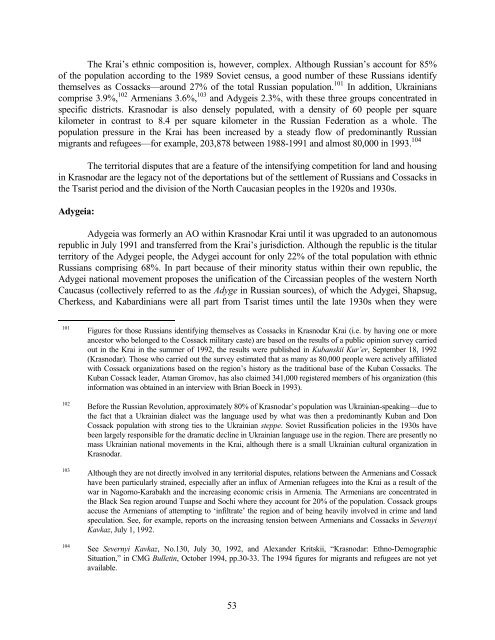RUSSIA'S TINDERBOX - Belfer Center for Science and International ...
RUSSIA'S TINDERBOX - Belfer Center for Science and International ...
RUSSIA'S TINDERBOX - Belfer Center for Science and International ...
Create successful ePaper yourself
Turn your PDF publications into a flip-book with our unique Google optimized e-Paper software.
The Krai’s ethnic composition is, however, complex. Although Russian’s account <strong>for</strong> 85%<br />
of the population according to the 1989 Soviet census, a good number of these Russians identify<br />
themselves as Cossacks—around 27% of the total Russian population. 101 In addition, Ukrainians<br />
comprise 3.9%, 102 Armenians 3.6%, 103 <strong>and</strong> Adygeis 2.3%, with these three groups concentrated in<br />
specific districts. Krasnodar is also densely populated, with a density of 60 people per square<br />
kilometer in contrast to 8.4 per square kilometer in the Russian Federation as a whole. The<br />
population pressure in the Krai has been increased by a steady flow of predominantly Russian<br />
migrants <strong>and</strong> refugees—<strong>for</strong> example, 203,878 between 1988-1991 <strong>and</strong> almost 80,000 in 1993. 104<br />
The territorial disputes that are a feature of the intensifying competition <strong>for</strong> l<strong>and</strong> <strong>and</strong> housing<br />
in Krasnodar are the legacy not of the deportations but of the settlement of Russians <strong>and</strong> Cossacks in<br />
the Tsarist period <strong>and</strong> the division of the North Caucasian peoples in the 1920s <strong>and</strong> 1930s.<br />
Adygeia:<br />
Adygeia was <strong>for</strong>merly an AO within Krasnodar Krai until it was upgraded to an autonomous<br />
republic in July 1991 <strong>and</strong> transferred from the Krai’s jurisdiction. Although the republic is the titular<br />
territory of the Adygei people, the Adygei account <strong>for</strong> only 22% of the total population with ethnic<br />
Russians comprising 68%. In part because of their minority status within their own republic, the<br />
Adygei national movement proposes the unification of the Circassian peoples of the western North<br />
Caucasus (collectively referred to as the Adyge in Russian sources), of which the Adygei, Shapsug,<br />
Cherkess, <strong>and</strong> Kabardinians were all part from Tsarist times until the late 1930s when they were<br />
101 Figures <strong>for</strong> those Russians identifying themselves as Cossacks in Krasnodar Krai (i.e. by having one or more<br />
ancestor who belonged to the Cossack military caste) are based on the results of a public opinion survey carried<br />
out in the Krai in the summer of 1992, the results were published in Kubanskii Kur’er, September 18, 1992<br />
(Krasnodar). Those who carried out the survey estimated that as many as 80,000 people were actively affiliated<br />
with Cossack organizations based on the region’s history as the traditional base of the Kuban Cossacks. The<br />
Kuban Cossack leader, Ataman Gromov, has also claimed 341,000 registered members of his organization (this<br />
in<strong>for</strong>mation was obtained in an interview with Brian Boeck in 1993).<br />
102 Be<strong>for</strong>e the Russian Revolution, approximately 80% of Krasnodar’s population was Ukrainian-speaking––due to<br />
the fact that a Ukrainian dialect was the language used by what was then a predominantly Kuban <strong>and</strong> Don<br />
Cossack population with strong ties to the Ukrainian steppe. Soviet Russification policies in the 1930s have<br />
been largely responsible <strong>for</strong> the dramatic decline in Ukrainian language use in the region. There are presently no<br />
mass Ukrainian national movements in the Krai, although there is a small Ukrainian cultural organization in<br />
Krasnodar.<br />
103 Although they are not directly involved in any territorial disputes, relations between the Armenians <strong>and</strong> Cossack<br />
have been particularly strained, especially after an influx of Armenian refugees into the Krai as a result of the<br />
war in Nagorno-Karabakh <strong>and</strong> the increasing economic crisis in Armenia. The Armenians are concentrated in<br />
the Black Sea region around Tuapse <strong>and</strong> Sochi where they account <strong>for</strong> 20% of the population. Cossack groups<br />
accuse the Armenians of attempting to ‘infiltrate’ the region <strong>and</strong> of being heavily involved in crime <strong>and</strong> l<strong>and</strong><br />
speculation. See, <strong>for</strong> example, reports on the increasing tension between Armenians <strong>and</strong> Cossacks in Severnyi<br />
Kavkaz, July 1, 1992.<br />
104 See Severnyi Kavkaz, No.130, July 30, 1992, <strong>and</strong> Alex<strong>and</strong>er Kritskii, “Krasnodar: Ethno-Demographic<br />
Situation,” in CMG Bulletin, October 1994, pp.30-33. The 1994 figures <strong>for</strong> migrants <strong>and</strong> refugees are not yet<br />
available.<br />
53
















